Drawing: Aleks. The girl was detained in autumn 2022 on the Article 342.1 (participating in mass protests), was released in summer 2024. The self-portraits on the diptych document two seasons in Gomel women’s colony. »Winter self-portrait. Transporting snow« (2024)
Vilnius Museum Hosts Female Prison Art from Belarus
This Ivan Lutskievič Belarusian Museum hosted an exhibition of drawings made by former Belarusian female political prisoners »Prison on the Outside, Not Inside«.

Ivan Lutskievič Belarusian Museum in Vilnius is a Belarusian scientific, educational and cultural organization founded in 2001 on the initiative of the public figure and culture activist Siarhei Vitushka The museum continues the traditions of the first Belarusian museum, which existed in 1921–1945 in Vilnius (then Vilna) in the Holy Trinity Monastery founded around the archive and collection of ethnographic, archeological and cultural artifacts of Ivan Lutskevich, an outstanding figure of the Belarusian national movement of the early 20th century, publicist and archaeologist. Since 2021, the museum has been located at 20, Vilenskaya Street. Headed by Ludovika Cardis, it now hosts art and photography exhibitions, poetry festivals, theatrical performances, lectures and workshops.

This autumn Ivan Lutskievič Belarusian Museum in Vilnius hosted an exhibition of drawings made by former Belarusian female political prisoners »Prison on the Outside, Not Inside«. The idea was
proposed by one of its future participants, while the project got implemented as a part of the larger initiative aimed at attracting attention to political repressions and the role of women in the struggle for democracy and human rights in Belarus initiated by the Free Belarus Museum in Warsaw with the support of the Canada Fund for Local Initiatives (CFLI).
The Vilnius exhibition featured the art works created in prison or immediately after the release by women persecuted after the suppression of the 2020 protests in Belarus. These women experienced illegal arrests, isolation, violence, and unbearable conditions in Belarusian jails, but retained their human dignity, ability to feel and empathize–the mood that undoubtedly dominated the museum halls. The women’s drawings document their experiences, fears, pain, but also hope, the energy of resistance and a clear awareness of the value of life and the price of freedom.



Comics drawings: Niko. The girl was arrested in winter 2022 under Article 342.1 (participation in mass protests) and sentenced to two years in prison, managed to escape punishment. The drawings were created during and after the arrest.
1. »I looked from the paddy wagon at people going to work and taking their kids to school, and thought about innocent people’s lives so easily ruined in front of everyone.« 2020. Gouache, ink, paper
2. »We arrived. They opened the doors and I went out, immediately lighting a cigarette. No way could I imagine it to be my last cigarette in ten days spent in Okrestina detention center.« 2020. Gouache, ink, paper
3. »They brought me to Okrestina. What an ominous place it is.« 2020. Gouache, ink, paper
Most exhibition participants preferred not to reveal their names and used pseudonyms instead, as they still do not feel safe and prefer to minimize risks of further political persecution. Some are consciously staying in Belarus despite danger, while others, in exile, fear for the safety of their loved ones and friends. We must understand that everything presented at the exhibition is, unfortunately, not the historical past, but a bitter Belarusian reality. The exhibition presents a reflection on the general trauma, which has absorbed thousands of personal tragedies, the scale of which we cannot yet assess, but which must undoubtedly be talked about in order to attract a wider public attention.
Many women mention that art gave meaning to their lives in the harsh conditions of imprisonment. Some purposefully carefully documented their prison routine to later tell those still unaware of the current horrible Belarusian realities about it.
»It’s like getting to Mars, to a completely different world which you had never thought of. Suspecting that other people might find it hard to believe you, you start documenting it to keep the evidence,« says Angela Devis, a graphic designer with the story of arrests, criminal prosecution, and a year-long sentence served in one of Belarusian penal colonies. The choice of the pen-name clearly shows the character and values of this woman inspired by the American feminist political activist.

Drawing: Angela Devis, a graphic designer from Minsk. She was arrested for participating in the 2020 protests and spent more than a year in Okrestina and so-called »Volodarka« prisons and Gomel women’s colony. The drawing illustrates the conditions of women’s imprisonment in Okrestina temporary detention center and the process of constant change of the inmates–»a carousel«. February 3–16, 2022
In her black-and-white compositions, Belarusian Angela documents the daily life of female political prisoners with amazing precision. Here is a punishment cell in Okrestina, a 2×3 meter room designed for one person and frequently used for keeping political prisoners. When the artist was there, the cell was overcrowded with eight inmates locked there.
People are usually held under the so-called »administrative arrest« in the temporary detention facility on Okrestina (Okrestina Street in Minsk). If there is no reason to initiate a criminal case, one is detained »for a day,« and then for another 10 days until a formal reason is found for further prosecution. Police call the process »a carousel«. Then the arrested are transported to court and transferred to the pretrial detention center on Voladarka (prison on Voladarsky Street in Minsk). The artist’s depiction of the Volodarka exercise yard amazes with its precision and maturity of execution, revealing a frightening image of suffering–the aesthetics of evil, both horrifying and attractive, as in the drawing from the Gomel colony, where female political prisoners carry their cellmate, who lost consciousness during a walk, to the medical unit on a blanket.

Drawing: Angela Devis. Gomel, penal colony #4. One of the convicts lost consciousness, her inmates use a medical blanket to transfort the woman to the prison medical unit
The exhibition in Vilnius has also become one of the forms of collective trauma representation and it aims at preventing social amnesia of such »uncomfortable« past and present. »If you want to know about prison, I will gladly tell you about it,« says a caption to one of Kasia Budko’s drawings. And it is natural that all these women have a passionate desire to talk about what they have felt, about their horrible experience of »falling into hell.« It is important for them to be heard and understood, despite the fact that people, afraid to harm them, sometimes tend to avoid such conversations, thereby unintentionally stigmatizing them. Kasia’s powerful quote is also being planned to be used as the name of a separate exhibition that the artist and her friend Yana Arabeyko would soon open with their prison drawings.
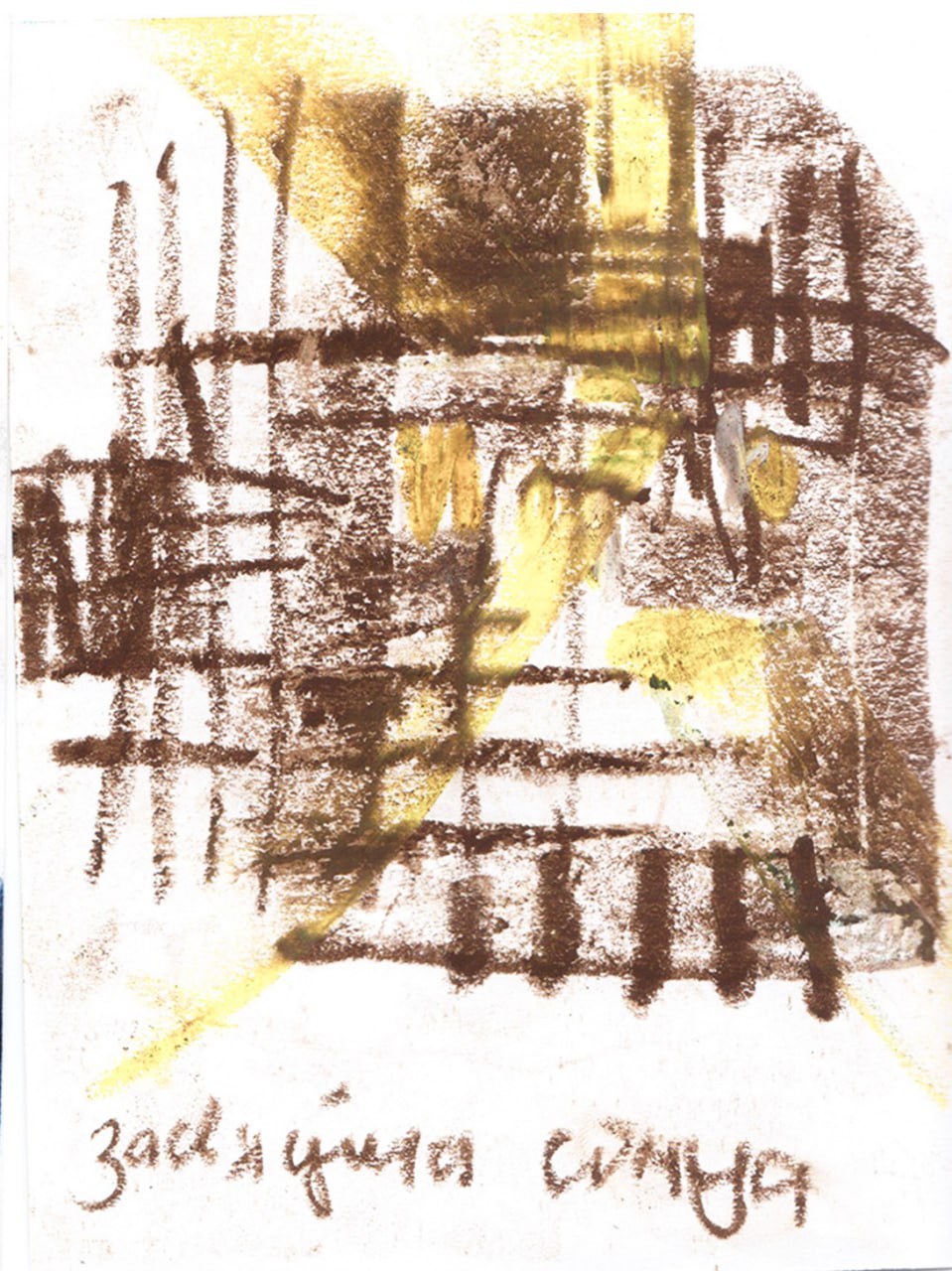
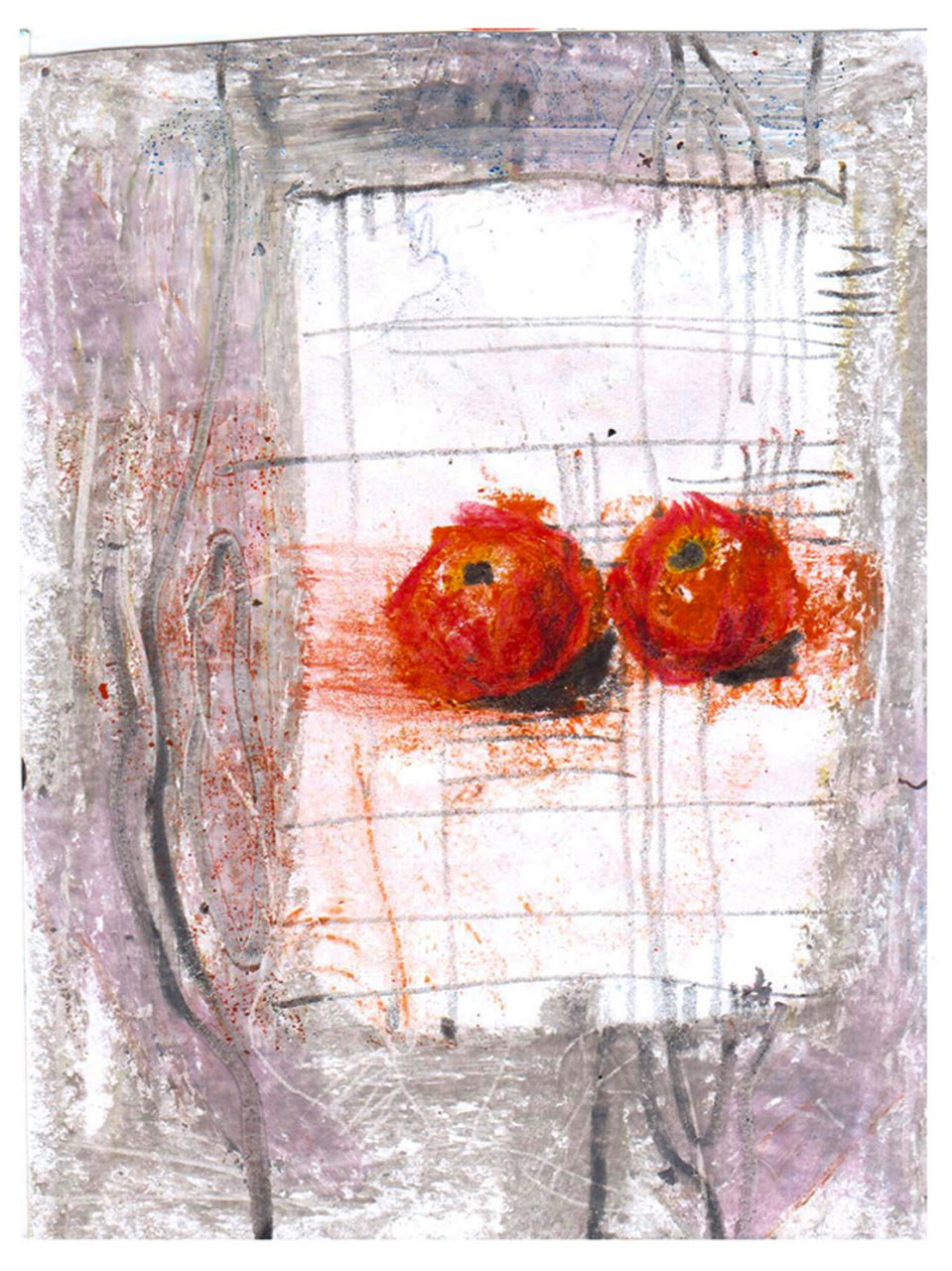
Drawings: Viktoryja, a designer. For participating in the 2020 protests, she received 15 days of arrest under the so-called »people’s« article 23.24. The art works are done with pastel pencil and are entitled »The sun shone« and »The apples« (2020)
The works presented at »Prison on the Outside, Not Inside« exhibition are primarily documents, evidence of the crimes of the political regime in Belarus. Their artistic value in this case is secondary, and not all the authors have an art education. However, these drawings, so different in execution and content, have a special aesthetics that touches our emotions no less than the meanings they present.
»I was very much inspired,« says Viktoryja, »because everything around me, even the clothes drying on the prison bars, was strange, but in a way beautiful. For example, the combination of colors… The walls in Okrestina were mustard-colored, it is such a bright accented background with no adequate lighting. You draw a bouquet of cornflowers, and against this background they seem unbearably blue. Or some apples on the table, for example. There happened to be a traditionally embroidered towel in the cell, and these apples resting on it… it was so beautiful, so homely, like our small protest. Even one insignificant detail of clothing could trigger the desire to draw. One of us, a mountaineer, wore striped clothes, and these stripes on the gray background seemed incredibly inspiring.«
Viktoryja and her friend Znichka were placed under administrative arrest after the 2020 protests, spending 15 days in the detention centers in Okrestina (Minsk) and Baranovichi. Their relatives were able to bring them pastel and graphite pencils (it was still possible back then), so their drawings have an ominous prison feel, expressed through a piercing palette of colors and dynamic lines that create recognizable images. In Znichka’s drawing »The Brush and a Boot« we see a repulsive image of prison boots, devoid of any individuality, let alone femininity, but which still attracted the artist as an artifact in which you can see something worthwhile, a reflection of the woman’s experience.
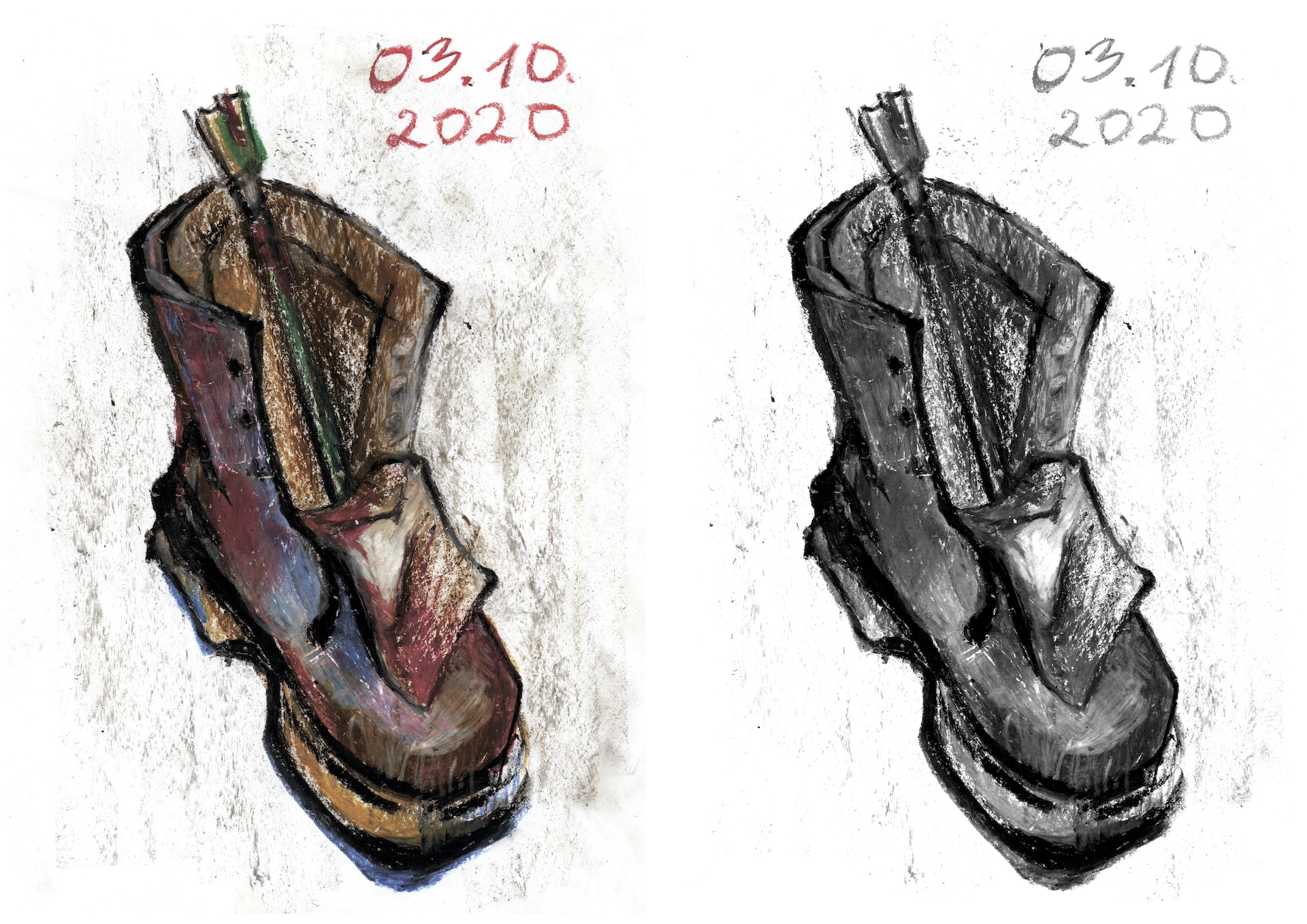
Drawings: ZNICHKA. For participating in the 2020 protests, she received 15 days of arrest under the so-called »people’s« article 23.24. The art work »The Brush and a Boot« is done with pastel pencil (2020)
Aleks spent two years behind bars, went through Volodarka pretrial detention center and a women’s colony. Her watercolor drawings were created immediately after her release, based on sketches made in prison. Two self-portraits–winter and summer ones–mercilessly convey the atmosphere of humiliation and suppression that political prisoners face in Belarusian prisons: from uniforms that destroy individuality to senseless and monotonous forced labor.
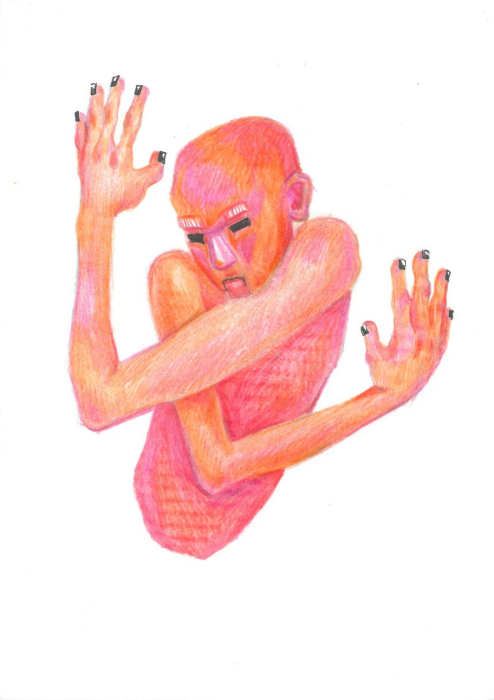
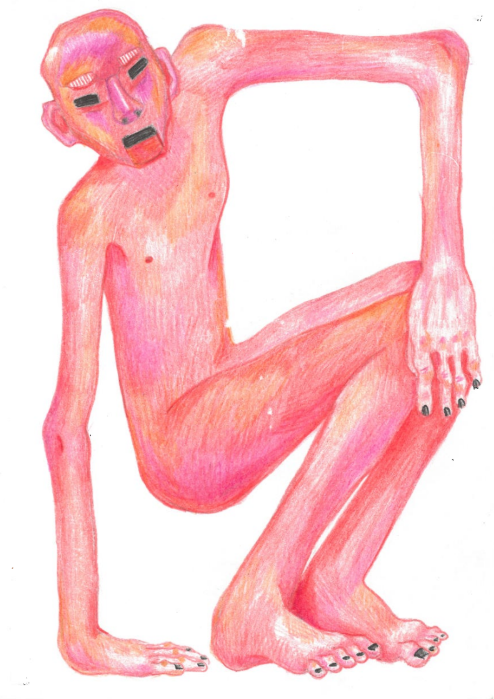
Drawings: Kasya Budko, a student, a member of the Association of Belarusian Students. Kasya was detained in 2020 under Article 342 of the Criminal Code of Belarus (organization and preparation of actions that grossly violate public order, or active participation in them). She was released on November 30, 2022. The series made watercolor pencil and ink is called »Little Red Men« (2021)
Kasia Budko’s drawings reveal an important detail of the experiences of a person who has encountered injustice and violence. Her series »Little Red Men« could be analyzed as reflecting vulnerability and helplessness of someone who has faced the Moloch of repressions: on the one hand, suffering and feeling depressed, naked in his forced cage, but at the same time–burning and ready to rebel…
Niko, who fled persecution and subsequent house arrest in Belarus, conveyed her story through a comic strip, in which she carefully drew details and added short captions. This is her way of storytelling–accessible and clear, especially for the youth, who should learn to develop empathy and the ability to listen to others, since it is on them who the future of the country they consider their homeland depends on.
The exhibition attracted significant attention becoming an important cultural event for Ivan Lutskievič Belarusian Museum in Vilnius. Not only did it tell the public about women’s resistance in Belarus, but also emphasized the importance of preserving the memory of people who continue to defend their civil rights, despite the threat of repression.
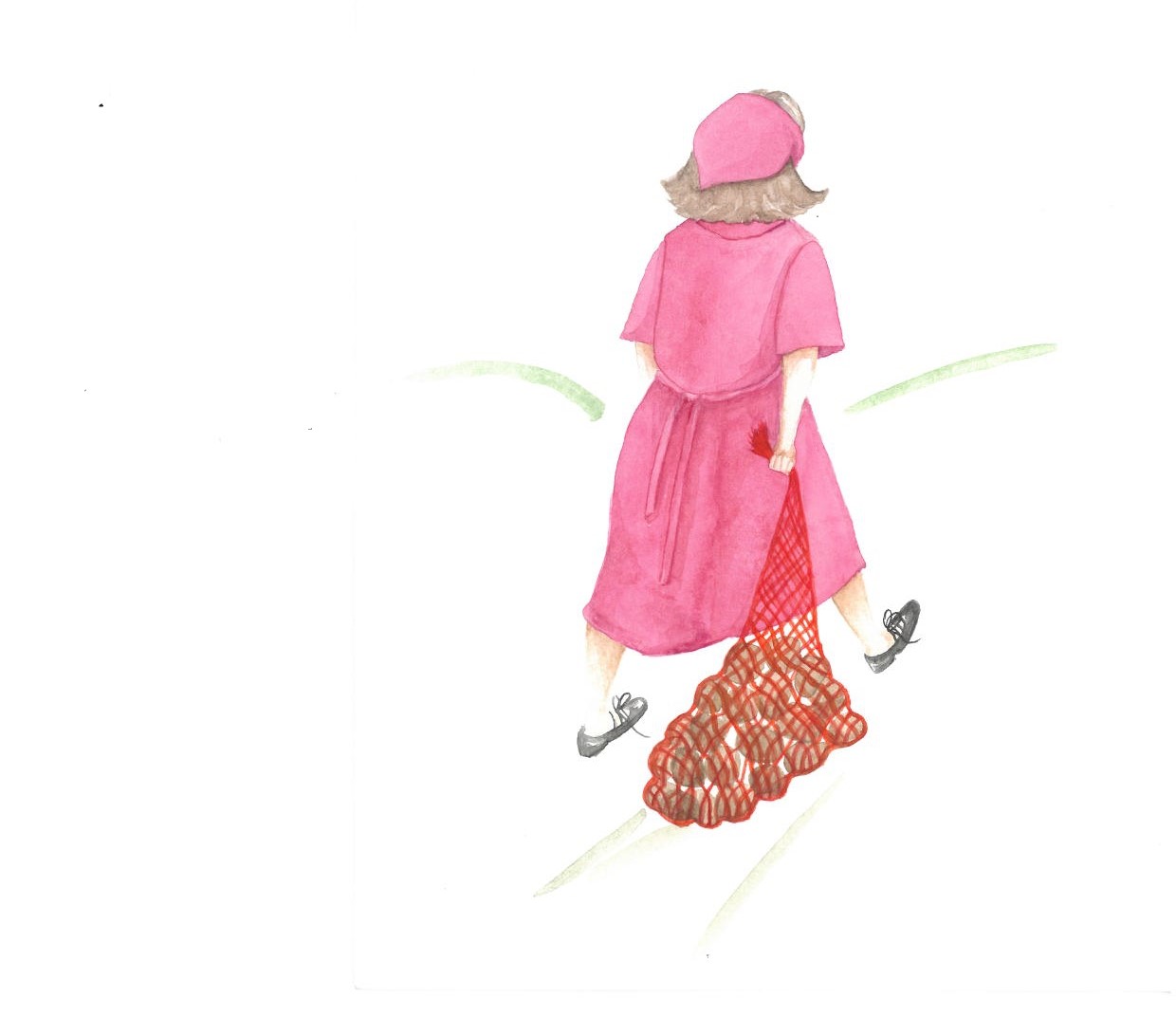
Drawing (fragment): Aleks. The girl was detained in autumn 2022 on the Article 342.1 (participating in mass protests), was released in summer 2024. The self-portraits on the diptych document two seasons in Gomel women’s colony. »Summer self-portrait. Carrying potatoes« (2024)